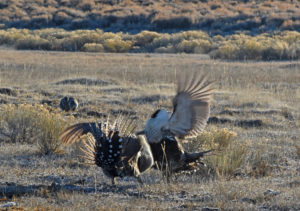For Immediate Release, October 2, 2019
Contacts:
Greta Anderson, Western Watersheds Project, (520) 623-1878, greta@westernwatersheds.org
Michael Saul, Center for Biological Diversity, (303) 915-8308, msaul@biologicaldiversity.org
Taylor Jones, WildEarth Guardians, (720) 443-2615, tjones@wildearthguardians.org
HAILEY, Idaho― Conservation groups submitted formal objections Tuesday to U.S. Forest Service plans that would further weaken greater sage-grouse protections despite plummeting grouse populations in the West.
The objections to Forest Service Plan amendments in Idaho, Wyoming, Colorado, Utah and Nevada lay the groundwork for a possible legal challenge to the weakening of greater sage-grouse conservation measures on national forests and grasslands.
“You might think that the declining sage-grouse populations would inspire the Forest Service to do more to save this species and avoid endangered species listing,” said Greta Anderson of Western Watersheds Project. “Instead the agency is hacking away further at the already inadequate conservation measures of the Obama administration plans.”
Greater sage-grouse populations are dwindling in all western states, even those with the last remaining strongholds for the species. Over the past few years sage-grouse numbers are down 61 percent in Utah, 33 percent in Nevada, 52 percent in Idaho and 44 percent in Wyoming. In Oregon the 43 percent decline is the lowest since reliable counts began more than 25 years ago. In North Dakota only 29 males came out to strut last spring.
“It’s tremendously disappointing to see the Forest Service push greater sage grouse further down the path of extinction,” said Michael Saul, a senior attorney at the Center for Biological Diversity. “The agency’s environmental analysis even tries to hide changes aimed at reducing protection for places sage grouse live. The public deserves honesty about these disturbing efforts to make it easier for oil and gas companies to destroy sage-grouse habitat in key areas like Utah’s Anthro Mountain and then pocket the profits.”
Greater sage grouse are considered an ecologically important “umbrella species,” requiring vast tracts of undisturbed habitats that harbor more than 350 other species of plants and wildlife also dependent on sagebrush habitats for key parts of their life cycles. Those animals include pronghorn, elk, mule deer, native trout, and migratory and resident birds.
“Stewardship of sage grouse is key to protecting elk winter ranges, pronghorn migration corridors, and golden eagle nesting habitats,” said Taylor Jones of WildEarth Guardians. “We need to be ramping up protections for this charismatic dancing bird and its sagebrush habitats, not slamming the door on conservation by turning our western sagebrush basins over to unregulated development.”
In March the conservation groups sued Interior Secretary David Bernhardt and the Bureau of Land Management over the new land-use plans, which rescinded or weakened 2015 plans on BLM land in the seven states with most of the remaining sage-grouse population. That complaint supplemented a 2016 lawsuit arguing that those earlier plans ― intended to avoid Endangered Species Act listing ― didn’t go far enough to protect the grouse.
The Forest Service plan amendments apply to five western states, but the greater sage-grouse range extends across 11 western states. These areas are the homelands for the Shoshone, Ute, Gosiute, Paiute, Cheyenne, Lakota and other indigenous peoples.






